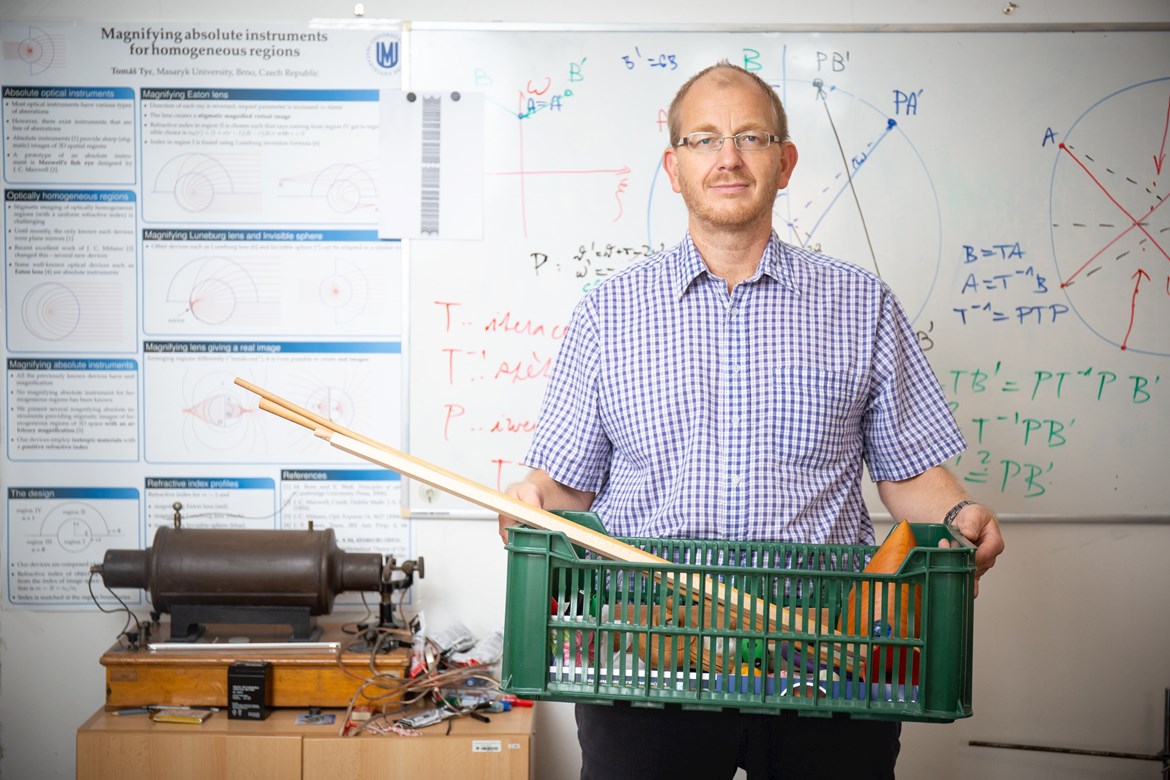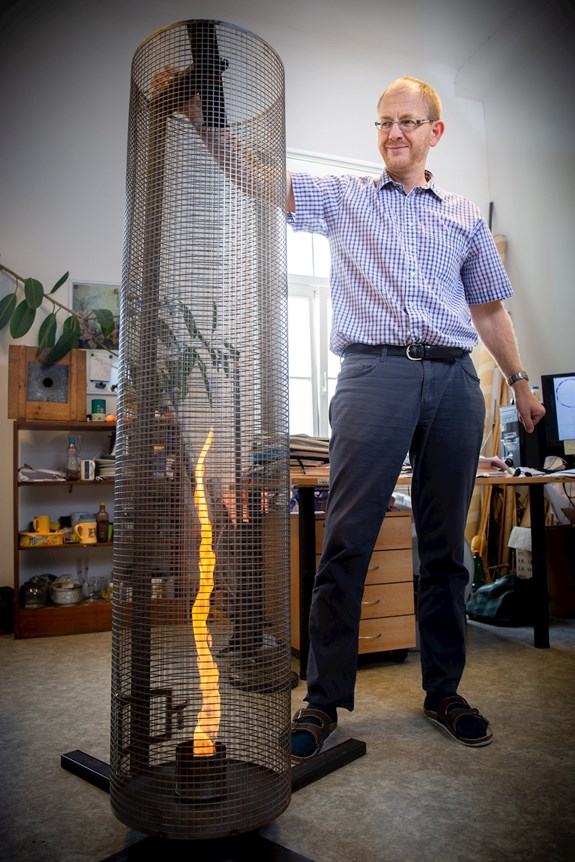Success Stories
The light in my students’ eyes when they understand what I try to explain is the best motivation, says Tomáš Tyc, a successful popularizer of physics
prof. Mgr. Tomáš Tyc, Ph.D.
Professor
Department of Theoretical Physics and Astrophysics
A holder of the 2020 Masaryk University Rector’s Award for outstanding teachers, winner of the 2019 MUNI Science Slam, co-author of educational series for Czech Television and Czech Radio, an avid popularizer of physics plus a successful researcher. Physics captivated him as early as at primary school and he still enjoys finding ways to show its charm to students and broader public.
Photo: Helena Brunnerová
How do you manage it all? Where do you find the ideas and motivation?
I don’t think I manage it all; I have given up some popularization lectures and focus on the preparation of a new lecture in mechanics, whose teaching I gradually take over from Prof. Jana Musilová, who has been teaching it in a fantastic way for a long time. It is a hard act to follow.
Your experience is vast; you made a show for children at Czech Television called “I will become an Einstein”. What was it like?
Cooperation with Czech Television was great experience. If you wish to explain something in front of a camera, you must say it simply and clearly for the audiences to understand. We often improvised; there was no time to have everything prepared word to word. I was surprised at how many times individual sections had to be repeated due to noise from the street or somebody’s mistake. I learnt not to be afraid of the camera.
Did the experience help you in your teaching?
It definitely did. Physics is not easy; it can be explained well, but also poorly. If people get a poor explanation, they think physics is too difficult and complicated and they stop trying to understand; they believe they are unable to get a grasp of it. However, if you give a good explanation, people start to see various connections, they are able to understand and deduct why things around us work as they do. We are able to explain the world around and people enjoy this. It makes sense to them.
How can such a complex discipline as physics be explained well?
It is good to use illustrative examples that help students imagine the issue. I, for instance, go to my classes with a fruit box full of aids I use to demonstrate my point. When I need to show a straight line, I take a rod; a particle may be represented by a small ball. Such aids are a great help in the classes. They can also be used for public lectures so that the audiences may see how practical it is and they could pass on the knowledge.

Weren’t you afraid of the Jan Kraus Show and how it would turn out?
I was perhaps a little bit afraid that Mr. Kraus would make a fool of me. He can be unpleasant, making fun of some guests, and I thought maybe a scientist, a physicist could be a good target. It seems, however, that I managed and wasn’t discouraged when some experiments didn’t work the first time. I stayed cool and that was important.
You won the 2019 MUNI Science Slam. Did the participation in the Jan Kraus Show help?
All these events are similar. You cut your eyeteeth with each presentation and become less nervous. At the science slam, it was important to keep the time limit for the performance. That was difficult. I rehearsed several times, but you mustn’t overdo the rehearsal for the speech to be authentic.
You have five children; do you ever rehearse with them as audiences?
I certainly do, but I try to restrain myself not to cause an opposite effect. I do a little home show when I see they are interested. I have printed a small flywheel on a 3D printer; it’s an interesting thing and when I set it spinning, my kids run to me, because they want to know how it works. They come to learn by themselves that physics virtually surrounds us.
Based on your experience, what would be your advice to colleagues who wish to attract the attention of the public with their research?
For instance, to avoid professional terminology. It may be detrimental if you use many specialized terms to look smart or if you even patronize your audiences. I try to avoid overly technical terms, although it's not always possible. The thing is to familiarize people with the world of science, to cause them realize that science deals with issues that are not confined to laboratories, but are very practical, too.
In your research, you worked with the theory of invisibility. What are your findings?
The principle of the invisibility cloak was included in the original proposals by professors Leonhardt and Pendry in 2006. The main idea is that the object you want to make invisible is wrapped in a material of a fine microscopic structure. This material then guides the incoming light so that it doesn’t fall on the object but bypasses it, like water bypassing an obstacle. The light has to return to the direction that it maintained before it approached the object so that the bypassing is not apparent.

What exactly did your work consist in?
The original theory was based on special resonance effects and thus the cloak could only work for light of a single wavelength. You can imagine that the invisibility would work only if you wear special glasses that let through just a narrow portion of the spectrum; however, at the moment you took off the glasses, the object would be visible again. Therefore, we proposed the use of the so-called non-Euclidean geometry – the geometry of curved space. There the light curves naturally. We published a proposal for an invisibility cloak that could work for a broader portion of the spectrum in Science in 2009. This was, however, a theoretical work. It would probably be very difficult to manufacture a material with the required physical properties.
So you do not continue in the research of the invisibility cloak?
Not at present; this work brought me to the research of so-called perfect lenses and later geodesic lenses; this is where I continue. The discipline began to develop recently and it has become a very promising field. Last year, I started cooperating with the European Space Agency, which considers the use of the geodesic lenses we designed as antennas for telecommunications satellites.
What is the advantage of geodesic lenses?
A geodesic lens can very well direct the signal in the form of waves. You can imagine an antenna that has no movable part, and yet is able to aim the signal at a moving receiver. The requirements for antenna directivity are very high due to the commencement of 5G mobile networks.
How does a geodesic lens work?
Imaging through conventional lenses is always imperfect. To eliminate such imperfections for example in a camera, several lenses must be used simultaneously. If we wanted a perfect image, we would need a perfect lens, whose designing involves a number of problems. Another possibility is geodesic lenses, where we force the light wave to move along a curved surface – for example, the surface of a sphere. The light on such a surface can be captured by a thin layer of glass: it cannot shine out due to a complete reflection. It’s easier with radio waves; it’s enough to create a gap between two metal surfaces of a suitable shape.
The principle of capturing the light: can it be utilized elsewhere?
Yes, for example with optical fibres in medicine and biology during detailed study of the processes that take place in the brain. The problem is that the light is reflected inside the fibre in a complicated way, and this causes some confusion of the information it carries. This is why, for example, an endoscope used in medicine to observe body cavities requires a bundle of dozens of thousands of optical fibres, each transmitting only one pixel of the image.

Do you have a solution to reduce the number of the necessary optical fibres?
There are fibres that transmit more pieces of information at a time. Experts previously thought that the way of light propagation in these types of optical fibres could be well predicted and so their capacity could be fully used. In cooperation with Prof. Tomáš Čižmár we have proved that this can be predicted with high precision even for common commercial fibres even in case the fibre is bent or otherwise deformed. Because we can calculate how the light in the fibre propagates, we can create an undistorted computer image.
Will you tell us about further direction of your research? What are you currently working on?
About a year ago, I encountered a remarkable phenomenon related to chaos theory. First imagine a pool table of a certain shape, not necessarily rectangular, and inside it a small ball that continuously bounces off its walls without any loss of energy. Depending on the table shape, the trajectory of the ball may fill in the entire area of the table or only a certain part and completely avoid another part. An interesting problem arises when the ball moves along a curved surface, a situation which is related to the geodesic lenses. This type of physics is not only interesting, but also aesthetic; the ball’s trajectories create beautiful patterns. Together with my doctoral student, we are trying to describe and understand the behaviour of the ball in such a system as best as we can.
This means a lot of new challenges. What is your motivation?
When I see that people grasp what I am trying to explain. The way their eyes light up. The fact that they can see the beauty that I see in physics. I am happy when I succeed in passing on the enthusiasm for the fascinating world around us.
Thank you for the interview.
Tereza Fojtová
Translation: Kevin Roche